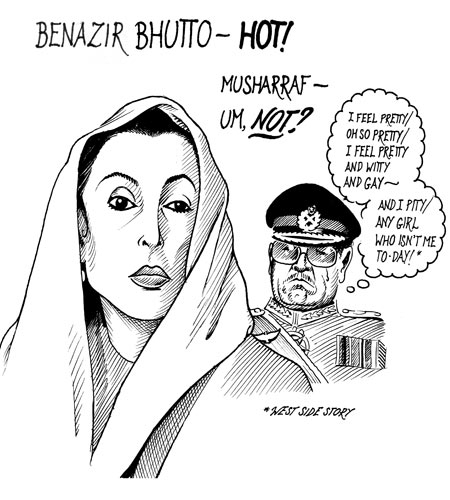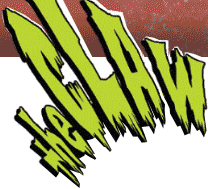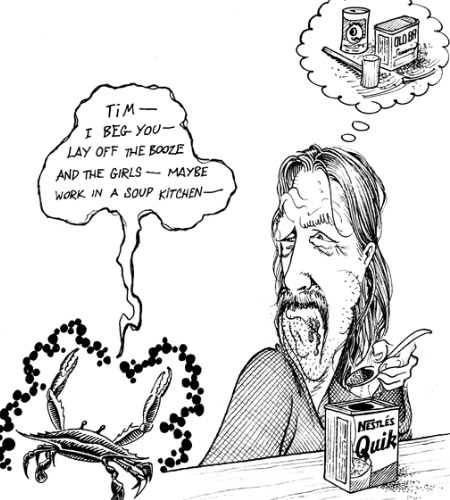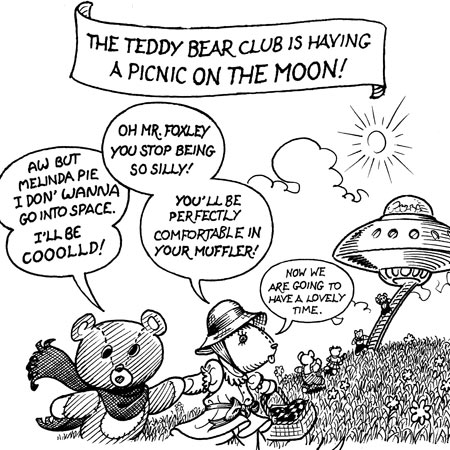A Conversation with Underground Cartoonist Tim Kreider
Tim Kreider* was born and educated in Baltimore, Maryland. His cartoon, The Pain – When Will It End?, has run in the Baltimore City Paper since 1997 and has also appeared in the Jackson Planet Weekly, The New York Press, The Stranger, and Philadelphia Weekly. Fantagraphics Books has published two collections of his cartoons, The Pain–When Will It End? (2004) and Why Do They Kill Me? (2005), and he was included in Ted Rall’s anthology Attitude 2: The New Subversive Alternative Cartoonists (2004). His essays have appeared in The New York Times, Film Quarterly, The Comics Journal, Jump Cut, and Lip. He divides his time between New York City and an undisclosed location on the Chesapeake Bay. *official bio text
C.L.A.W. was intensely pleased to sit down with Tim Kreider to talk with him about his glorious craft.
C.L.A.W. How do you make your cartoons? Do you pencil then ink/scan or do you draw them into photoshop with a wacom tablet?
T.K. I draw with pens on pieces of paper and then scan them in at unnecessarily high resolution. Wacom tablets are very handy for jiffying up mistakes in Photoshop, but I imagine it would be about as easy to draw a fine, controlled, expressive line with one as with a wood-burner or a garden hose.
C.L.A.W. Have any of your cartoons been censored and does it hurt your feelings?
T.K. I can only think of two times that the City Paper refused to run cartoons of mine. One was the “New Design for the World Trade Center,” which I sent them the week after 9/11. This was actually an uncharacteristically affirmative, boosterish cartoon for me, and not that dissimilar to the photoshopped image of the rebuilt WTC giving the world the finger that circulated on the internet around that time. But the publisher’s feeling–not my editor’s–was that any representation of the World Trade Centers at that time would be inappropriate. His actual words, which I have not forgotten, were that it “would jeopardize our standing in the community.” I was like, Jeez Louise. Nevertheless they ran the same cartoon a week later, after everyone had started to return to sanity. I wasn’t pleased at the time, but I can’t say I was all that hurt or indignant, either. I had more important things on my mind and it was a very weird week–people reacted in all kinds of strange ways and I’m sure everyone was trying to do what what felt right at the time, whether it was volunteering for the Red Cross in Manhattan or censoring cartoons or hiding at airbases in Louisiana.
The other cartoon was “Me, the Freeloadin’ Negro,” which I sent them a week after some other cartoon, which wasn’t actually about race, had inadvertently caused outrage in the letters pages among some African-American readers. Again, the issue was mostly timing.
Come to think of it they never ran “Graveyard Shift at the Pussy Juice Factory,” either, but this is a drawing I would expect no respectable publication ever to run anywhere in the civilized world.
C.L.A.W. Does having an enemies list on your website increase loyalty of your fan base?
T.K. You would have to ask the fans. I don’t think anyone’s reading my cartoons week after week for fear of ending up on my bad side, if that’s what you’re getting at. In truth it’s been a long time since I’ve even looked at the Enemies List–doubtless it’s in need of updating. It did my vindictive heart a lot of good to create it years ago, but now that I am middle-aged I’m trying to become a less rancorous person before I end up a bitter little old man and I think, from time to time, of eliminating it. I would advise everybody to make up an enemies list for fun and then tear it up.
 C.L.A.W. How do you know when a cartoon is a hit? What are the indicators?
C.L.A.W. How do you know when a cartoon is a hit? What are the indicators?
T.K. My only real indication is the number and enthusiasm of emails and letters I receive in response. Of course it’s possible this is an indicator not of a cartoon’s popularity but of its provocativeness. Some of them just provide more fodder for discussion than others. Webmaster Dave keeps a list of the all-time most popular cartoons but I myself don’t know how to measure this. It’s sometimes a mystery to me why people like the cartoons they do–the same way, I’m sure, it’s a mystery to a comedian when one of his lines becomes a national catch-phrase. The most popular of my cartoons don’t necessarily correlate to the ones I think are the best. Sometimes, I’m sure, people like them because of superficial or random reasons. As with any kind of art, all you can do is throw it out there and hope it’ll resonate with somebody.
C.L.A.W. What are elements that you look for in a provocative freethinking cartoon/comic?
T.K. I’m not sure whether you’re talking about my own comics or other people’s, but perhaps my answer is the same in either case. I don’t usually try to reverse-engineer a cartoon that’ll illustrate an abstract idea or argument when I draw; I just try to think up funny things. Similarly, I don’t have any criteria for cartoons that I seek out or like; all I want is not to be bored. I have to confess I don’t have much interest in comics per se and don’t read that many of them. Obviously I like cartoons that are intelligent, artful, and preferably hilarious. I think the best political cartoonists from the last dismal eight years have been Steve Bell and Ruben Bolling. (But bear in mind that I haven’t read two Doonesburys in a row since the Vietnam War ended and I never even bother to look at any daily newspaper editorial cartoons, so it’s not like I know what I’m talking about.) The only one of my colleagues’ work I check in on on a weekly basis is Emily Flake. I would say that Emily and I share what you might call a Baltimorean sensibility (a city where she and I have both spent significant parts of our lives): a certain preoccupation with the sordid and the unwise–with drunkenness, ill-advised sex, poor work habits–and what Frederic Raphael, in speaking of Stanley Kubrick, described as “an amused pessimism at the notion that people are capable of change.” [not 100% certain of the accuracy of this quote]
C.L.A.W. Thanks Mr. Kreider, god bless!
T.K. You are welcome; we will see.
Extra Credit Reading – That’s Not Funny: Rage, Laughter, and Political Cartooning After 9/11
Mr. Kreider’s book Why Do They Kill Me? can be purchased locally through Fantagraphics Books.





